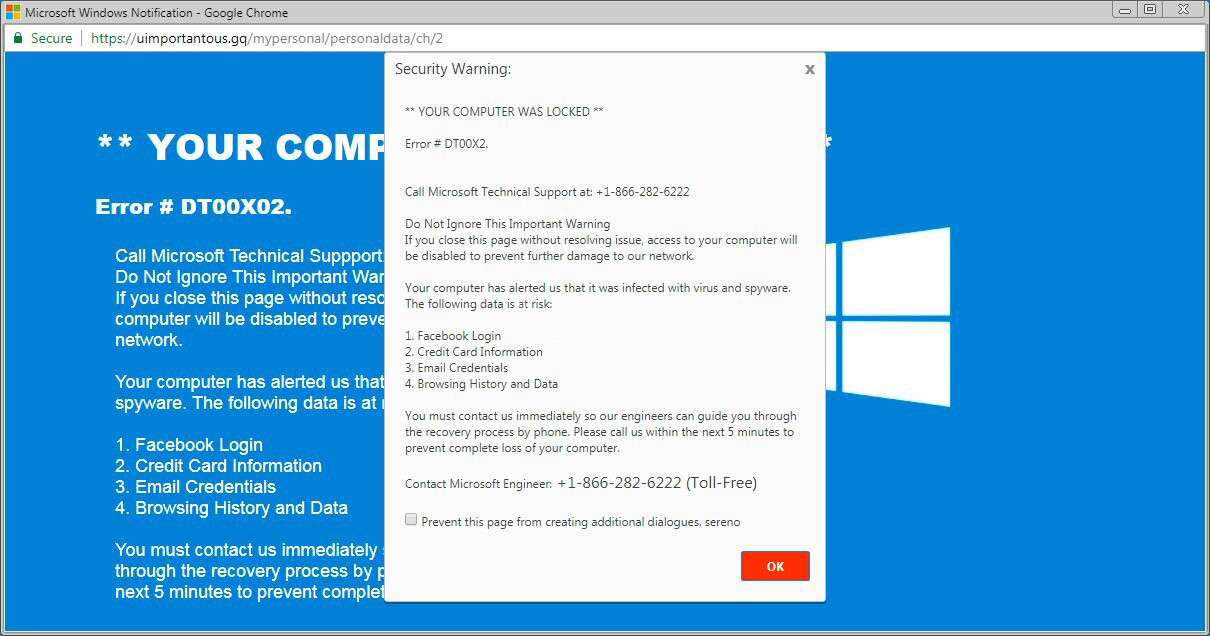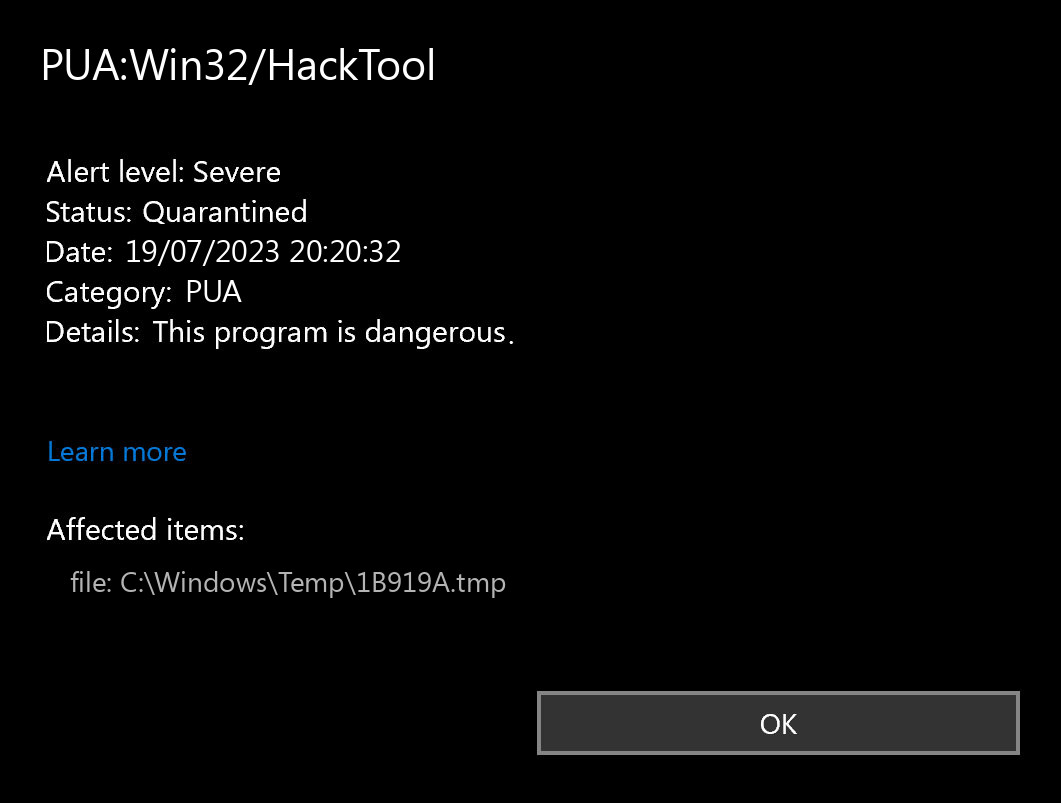PUA:Win32/HackTool is a generic detection name used by Microsoft Defender and other security software to identify potentially unwanted applications (PUAs) that fall under the category of “HackTools.” These are software tools or utilities that can be misused for illicit purposes or to gain unauthorized access to systems, networks, or sensitive information.
HackTools are not inherently malicious; they often serve legitimate purposes in the hands of system administrators, cybersecurity professionals, or other authorized users. However, they can also be used by malicious actors to compromise security or violate privacy.
Examples of HackTools include password-cracking utilities, network scanning tools, keyloggers, and other software designed for unauthorized system access, password theft, or exploiting vulnerabilities in systems and software.
Since HackTools have the potential to be misused for malicious activities, antivirus programs and security software flag them as potentially unwanted applications. When PUA:Win32/HackTool is detected, it is recommended to carefully assess the tool’s intended use, ensure it is being used responsibly and within the boundaries of the law and ethical standards.
Users should avoid downloading HackTools from untrusted sources or using them for any malicious purposes. Instead, they should rely on authorized and legal means to access or recover sensitive information and maintain the security of their systems and data.
Any type of malware exists with the only target – generate profits on you. And the programmers of these things are not thinking about morality – they use all possible ways. Grabbing your private data, getting the payments for the banners you watch for them, exploiting your system to mine cryptocurrencies – that is not the full list of what they do. Do you like to be a riding steed? That is a rhetorical question.
What does the pop-up with PUA:Win32/HackTool detection mean?
The PUA:Win32/HackTool detection you can see in the lower right corner is shown to you by Microsoft Defender. That anti-malware program is good at scanning, but prone to be mainly unstable. It is vulnerable to malware invasions, it has a glitchy interface and bugged malware removal capabilities. Therefore, the pop-up which says concerning the HackTool is simply an alert that Defender has detected it. To remove it, you will likely need to use a separate anti-malware program.
PUA:Win32/HackTool unwanted program is a typical example of PUA, which are quite common nowadays. Being free to use, it may give you “the extended functions” for the additional payment. Some instances of this program type can have no real functions whatsoever – only the shell with the kaleidoscopic interface. You can see it advertised as a system optimization software, driver updater or torrent downloadings tracker. This or another way it does not give you any type of true capability, exposing you to risk instead.
Unwanted Program Summary:
| Name | HackTool PUA |
| Detection | PUA:Win32/HackTool |
| Damage | HackTool is at least useless, or can perform various malicious actions on your PC. |
| Fix Tool | See If Your System Has Been Affected by HackTool exploit |
Is PUA:Win32/HackTool dangerous?
I have actually mentioned that PUA:Win32/HackTool PUA is not as harmless as it pretends to be. The “legitimate and useful” application can abruptly unveil itself as a downloader trojan, spyware, backdoor, or coin miner virus. And you can never foresee what to look for even from different variants of HackTool unwanted program. That still does not imply that you need to panic – possibly, this unpleasant thing has not succeeded to do bad things to your PC.
The particular harm to your system may be caused not just because of the malware injection. A large share of questionable programs, like the HackTool application is, is just poorly developed. Potentially, their actions are fairly effective than pointless if done on certain system setups, however, not on each one. That’s how a basic system optimization program may cause disorder with continuous BSODs on your system. Any interruptions to the system registry are unsafe, and they are a lot more unsafe if done with such programs.
How did I get this virus?
It is difficult to line the sources of malware on your computer. Nowadays, things are mixed, and distribution tactics utilized by adware 5 years ago can be used by spyware these days. But if we abstract from the exact spreading method and will think of why it works, the answer will be pretty simple – low level of cybersecurity awareness. People click on ads on weird sites, click the pop-ups they get in their web browsers, call the “Microsoft tech support” assuming that the weird banner that says about malware is true. It is necessary to recognize what is legitimate – to avoid misunderstandings when attempting to identify a virus.

The example of Microsoft Tech support scam banner
Nowadays, there are two of the most common tactics of malware spreading – bait emails and injection into a hacked program. While the first one is not so easy to avoid – you must know a lot to recognize a counterfeit – the second one is simple to address: just do not use cracked applications. Torrent-trackers and other providers of “free” applications (which are, actually, paid, but with a disabled license checking) are really a giveaway point of malware. And PUA:Win32/HackTool is just within them.
Remove HackTool with Gridinsoft Anti-Malware
We have also been using this software on our systems ever since, and it has always been successful in detecting viruses. It has blocked the most common PUAs as shown from our tests with the software, and we assure you that it can remove HackTool as well as other malware hiding on your computer.

To use Gridinsoft for remove malicious threats, follow the steps below:
1. Begin by downloading Gridinsoft Anti-Malware, accessible via the blue button below or directly from the official website gridinsoft.com.
2.Once the Gridinsoft setup file (setup-gridinsoft-fix.exe) is downloaded, execute it by clicking on the file.

3.Follow the installation setup wizard's instructions diligently.

4. Access the "Scan Tab" on the application's start screen and launch a comprehensive "Full Scan" to examine your entire computer. This inclusive scan encompasses the memory, startup items, the registry, services, drivers, and all files, ensuring that it detects malware hidden in all possible locations.

Be patient, as the scan duration depends on the number of files and your computer's hardware capabilities. Use this time to relax or attend to other tasks.
5. Upon completion, Anti-Malware will present a detailed report containing all the detected malicious items and threats on your PC.

6. Select all the identified items from the report and confidently click the "Clean Now" button. This action will safely remove the malicious files from your computer, transferring them to the secure quarantine zone of the anti-malware program to prevent any further harmful actions.

8. If prompted, restart your computer to finalize the full system scan procedure. This step is crucial to ensure thorough removal of any remaining threats. After the restart, Gridinsoft Anti-Malware will open and display a message confirming the completion of the scan.
Remember Gridinsoft offers a 6-day free trial. This means you can take advantage of the trial period at no cost to experience the full benefits of the software and prevent any future malware infections on your system. Embrace this opportunity to fortify your computer's security without any financial commitment.
Trojan Killer for “HackTool” removal on locked PC
In situations where it becomes impossible to download antivirus applications directly onto the infected computer due to malware blocking access to websites, an alternative solution is to utilize the Trojan Killer application.

There is a really little number of security tools that are able to be set up on the USB drives, and antiviruses that can do so in most cases require to obtain quite an expensive license. For this instance, I can recommend you to use another solution of GridinSoft - Trojan Killer Portable. It has a 14-days cost-free trial mode that offers the entire features of the paid version. This term will definitely be 100% enough to wipe malware out.
Trojan Killer is a valuable tool in your cybersecurity arsenal, helping you to effectively remove malware from infected computers. Now, we will walk you through the process of using Trojan Killer from a USB flash drive to scan and remove malware on an infected PC. Remember, always obtain permission to scan and remove malware from a computer that you do not own.
Step 1: Download & Install Trojan Killer on a Clean Computer:
1. Go to the official GridinSoft website (gridinsoft.com) and download Trojan Killer to a computer that is not infected.

2. Insert a USB flash drive into this computer.
3. Install Trojan Killer to the "removable drive" following the on-screen instructions.

4. Once the installation is complete, launch Trojan Killer.
Step 2: Update Signature Databases:
5. After launching Trojan Killer, ensure that your computer is connected to the Internet.
6. Click "Update" icon to download the latest signature databases, which will ensure the tool can detect the most recent threats.

Step 3: Scan the Infected PC:
7. Safely eject the USB flash drive from the clean computer.
8. Boot the infected computer to the Safe Mode.
9. Insert the USB flash drive.
10. Run tk.exe
11. Once the program is open, click on "Full Scan" to begin the malware scanning process.

Step 4: Remove Found Threats:
12. After the scan is complete, Trojan Killer will display a list of detected threats.

13. Click on "Cure PC!" to remove the identified malware from the infected PC.
14. Follow any additional on-screen prompts to complete the removal process.

Step 5: Restart Your Computer:
15. Once the threats are removed, click on "Restart PC" to reboot your computer.
16. Remove the USB flash drive from the infected computer.
Congratulations on effectively removing HackTool and the concealed threats from your computer! You can now have peace of mind, knowing that they won't resurface again. Thanks to Gridinsoft's capabilities and commitment to cybersecurity, your system is now protected.
How to Remove PUA:Win32/HackTool Malware
Name: PUA:Win32/HackTool
Description: PUA:Win32/HackTool is a classification used by Microsoft Defender and other antivirus software to identify potentially unwanted applications (PUAs) that fall under the category of hacking tools. These tools are designed to perform various hacking or cracking activities, which may include unauthorized access, password cracking, network scanning, or other activities that can compromise computer security. While hacking tools can have legitimate uses in specific scenarios, such as cybersecurity research, network testing, or forensic analysis, they are often associated with malicious intent and can pose a significant risk to computer systems and user privacy. These tools are commonly used by cybercriminals to exploit vulnerabilities, gain unauthorized access to systems, steal sensitive information, or launch other malicious activities.
Operating System: Windows
Application Category: PUA


